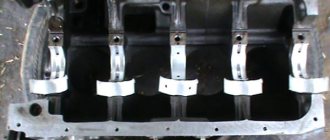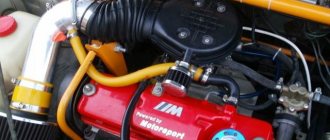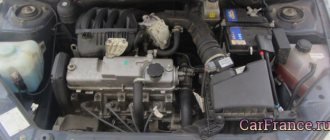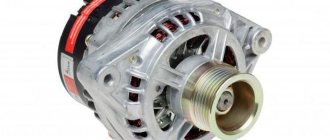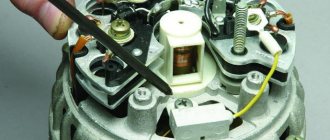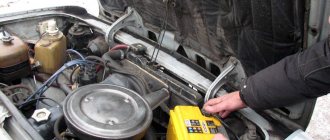What engines did the “fives” come with?
Throughout its history, the VAZ 2105 came off the assembly line with five different engines:
- 2101;
- 2105;
- 2103;
- 2104;
- 21067;
- BTM-341;
- 4132 (RPD).
They differed not only in technical characteristics, but also in the type of design, type of fuel consumed, as well as the method of supplying it to the combustion chambers. Let's look at each of these power units in detail.
The VAZ 2105 engine has a transverse arrangement
More about the design and characteristics of the VAZ-2105: https://bumper.guru/klassicheskie-modeli-vaz/poleznoe/vaz-2105-inzhektor.html
Engine VAZ 2101
The first unit installed on the “five” was an old “penny” engine. It did not have any special power qualities, but it had already been tested and proved to be excellent.
Table: main characteristics of the VAZ 2101 engine
| Characteristic name | Index |
| Cylinder arrangement | Row |
| Number of cylinders | 4 |
| Type of fuel | Gasoline AI-92 |
| Number of valves | 8 |
| Method of supplying fuel to the cylinders | Carburetor |
| Power unit volume, cm3 | 1198 |
| Cylinder diameter, mm | 76 |
| Amplitude of piston movement, mm | 66 |
| Torque value, Nm | 89,0 |
| Unit power, hp | 64 |
Engine VAZ 2105
The “five” had its own power unit specially developed. It was an improved version of the VAZ 2101 engine, characterized by a larger cylinder volume with the same piston stroke.
Table: main characteristics of the VAZ 2105 engine
| Characteristic name | Index |
| Cylinder arrangement | Row |
| Number of cylinders | 4 |
| Type of fuel | Gasoline AI-93 |
| Number of valves | 8 |
| Method of supplying fuel to the cylinders | Carburetor |
| Power unit volume, cm3 | 1294 |
| Cylinder diameter, mm | 79 |
| Amplitude of piston movement, mm | 66 |
| Torque value, Nm | 94,3 |
| Unit power, hp | 69 |
Engine VAZ 2103
The “three-piece” engine was even more powerful, however, not due to an increase in the volume of the combustion chambers, but thanks to a modified crankshaft design, which made it possible to slightly increase the piston stroke. A crankshaft of the same design was installed on the Niva. VAZ 2103 engines were equipped from the factory with both contact and non-contact ignition systems.
Table: main characteristics of the VAZ 2103 engine
| Characteristic name | Index |
| Cylinder arrangement | Row |
| Number of cylinders | 4 |
| Type of fuel | Gasoline AI-91, AI-92, AI-93 |
| Number of valves | 8 |
| Method of supplying fuel to the cylinders | Carburetor |
| Power unit volume, cm3 | 1,45 |
| Cylinder diameter, mm | 76 |
| Amplitude of piston movement, mm | 80 |
| Torque value, Nm | 104,0 |
| Unit power, hp | 71,4 |
Engine VAZ 2104
The power unit of the fourth Zhiguli model, which was installed on the VAZ 2105, differed in the type of injection. Here, not a carburetor was used, but electronically controlled injectors. The engine has undergone some changes regarding the installation of components for injection supply of the fuel mixture, as well as several monitoring sensors. In all other respects, it was practically no different from the carburetor “three-piece” engine.
Table: main characteristics of the VAZ 2104 engine
| Characteristic name | Index |
| Cylinder arrangement | Row |
| Number of cylinders | 4 |
| Type of fuel | Gasoline AI-95 |
| Number of valves | 8 |
| Method of supplying fuel to the cylinders | Distributed injection |
| Power unit volume, cm3 | 1,45 |
| Cylinder diameter, mm | 76 |
| Amplitude of piston movement, mm | 80 |
| Torque value, Nm | 112,0 |
| Unit power, hp | 68 |
Engine VAZ 21067
Another unit that equipped the “five” was borrowed from the VAZ 2106. In fact, this is a modified version of the VAZ 2103 engine, where all modifications were reduced to increasing power by increasing the diameter of the cylinders. But it was this engine that made the “six” the most popular car due to its reasonable ratio of the amount of fuel consumed and the power developed.
Table: main characteristics of the VAZ 21067 engine
| Characteristic name | Index |
| Cylinder arrangement | Row |
| Number of cylinders | 4 |
| Type of fuel | Gasoline AI-91, AI-92, AI-93 |
| Number of valves | 8 |
| Method of supplying fuel to the cylinders | Carburetor |
| Power unit volume, cm3 | 1,57 |
| Cylinder diameter, mm | 79 |
| Amplitude of piston movement, mm | 80 |
| Torque value, Nm | 104,0 |
| Unit power, hp | 74,5 |
Engine BTM 341
BTM-341 is a diesel power unit that was installed on classic VAZs, including the “five”. Basically, such cars were exported, but they could also be found here. The BTM-341 engines were neither particularly powerful nor low in fuel consumption, which is apparently why diesel Zhigulis did not take root in the USSR.
Table: main characteristics of the BTM 341 engine
| Characteristic name | Index |
| Cylinder arrangement | Row |
| Number of cylinders | 4 |
| Type of fuel | Diesel fuel |
| Number of valves | 8 |
| Method of supplying fuel to the cylinders | Direct injection |
| Power unit volume, cm3 | 1,52 |
| Torque value, Nm | 92,0 |
| Unit power, hp | 50 |
Engine VAZ 4132
Installed on “five” and rotary engines. At first, these were prototypes, and then mass production. The VAZ 4132 power unit developed twice as much power as all other Zhiguli engines. For the most part, “fives” with rotary engines were provided to police units and special services, but ordinary citizens could also purchase them. Today it is rare, but you can still find a VAZ with a 4132 engine or similar.
Table: main characteristics of the VAZ 4132 engine
| Characteristic name | Index |
| Method of supplying fuel to the cylinders | Carburetor |
| Type of fuel | AI-92 |
| Power unit volume, cm3 | 1,3 |
| Torque value, Nm | 186,0 |
| Unit power, hp | 140 |
Design nuances
To obtain the above engine characteristics, the manufacturer carried out experiments:
- piston stroke reduced to 66 mm;
- the cylinder diameter, on the contrary, is increased to 79 mm.
The result was a revving, powerful engine with an aluminum valve cover that absorbed the sounds of the drive. Another feature of the internal combustion engine is the fastening of the timing belt pulley - users do not need to unscrew the bolt on the crankshaft, unlike previous VAZ engine models.
Design 2105
In the operating instructions, the manufacturer recommends which oil to pour into the engine - 5W30 - 15W40.
What engine can be installed on a VAZ 2105 instead of the standard one?
The “Five” can be easily equipped with a power unit from any other “classic”, be it a carburetor VAZ 2101 or an injection VAZ 2107. However, connoisseurs of real tuning prefer engines from foreign cars. Power plants from a “close relative” – Fiat – are best suited for these purposes. Its models “Argenta” and “Polonaise” are equipped with engines that fit into our VAZs without any problems.
The engine from Fiat can be installed on the “five” without modifications
Fans of more powerful engines can try to install a power unit from a Mitsubishi Galant or Renault Logan with a volume of 1.5 to 2.0 cm3. Here, of course, you will have to change the mounts for the engine itself and for the gearbox, however, if everything is done correctly, the result will surprise you. But it is important not to overdo it, because each body is designed for a certain load, including engine power.
Well, for those who want to drive a unique car, we can advise equipping their “five” with a rotary power unit. The cost of such an engine today is 115–150 thousand rubles, but no modifications will be required to install it. It will fit perfectly on any “classic” VAZ.
Police and special services vehicles were equipped with rotary engines.
Also check out the design of the VAZ 2105 generator: https://bumper.guru/klassicheskie-modeli-vaz/generator/generator-vaz-2105.html
Service for searching the characteristics of the original battery
The service for selecting batteries for VAZ cars is located on this page. Follow the link and on the page you will see a form for entering the model and modification of the car. Below you can read instructions for using the service. The selection process is outlined there step by step. These steps can be seen visually in the picture below.
Now let’s look at how selection works using the example of a specific modification of the VAZ-2105. Return to content
An example of selecting a battery for a VAZ-2105 using the service
All modifications of the VAZ-2105, regardless of the engine, were equipped with batteries with the same characteristics. Therefore, as an example, it will be enough to consider one option. Let’s take, for example, the VAZ-2105 “five” with the VAZ-2106 engine (distributed injection, 1.6 l, 80 hp) and 5-speed. Manual transmission. The car was produced from 1985 to 2011.
Currently, the service for selecting batteries for VAZ (Lada) cars is operating in test mode. Information about car models, modifications and data on batteries for them is supplemented. Please note that there may be errors, incomplete information and typographical errors. We recommend checking the data obtained in the selection with information from other sources. If you find errors, please report them to the site administration in this forum thread. We will double-check the information and correct errors. Also leave your feedback on the selection process. Thank you! Return to content
Main malfunctions of VAZ 2105 engines
If you do not take into account the power plants of the BTM 341 and VAZ 4132, the VAZ 2105 engines are not much different from each other. They have a similar design, and, therefore, they experience the same malfunctions. The main signs that the motor has failed are:
- impossibility of starting it;
- unstable operation at idle;
- violation of normal temperature conditions (overheating);
- power drop;
- change in exhaust color (white, gray);
- the occurrence of extraneous noise in the power unit.
Let's find out what the listed symptoms may indicate.
Inability to start the engine
The power unit will not start if:
- lack of voltage on the spark plugs;
- problems in the power system that prevent the fuel-air mixture from entering the cylinders.
The absence of a spark at the spark plug electrodes may be due to a malfunction:
- the candles themselves;
- high-voltage wires;
- ignition distributor;
- ignition coils;
- breaker (for cars with contact ignition);
- switch (for cars with contactless ignition)
- Hall sensor (for cars with a contactless ignition system);
- ignition switch.
Fuel may not flow into the carburetor and from there into the cylinders due to:
- clogged fuel filter or fuel line;
- fuel pump malfunction;
- obstruction of the carburetor inlet filter;
- malfunction or incorrect carburetor adjustment.
Unstable operation of the power unit at idle speed
Violation of the stability of the power unit at idle may indicate:
- malfunction of the carburetor solenoid valve;
- failure of one or more spark plugs, breakdown of insulation or violation of the integrity of the current-carrying conductor of a high-voltage wire;
- burning of breaker contacts;
- improper adjustment of the quantity and quality of fuel used to form the fuel-air mixture.
More about the VAZ 2105 ignition system: https://bumper.guru/klassicheskie-modeli-vaz/elektrooborudovanie/zazhiganie/kak-vystavit-zazhiganie-na-vaz-2105.html
Overheat
The normal temperature of a running VAZ 2105 engine is 87–950C. If its performance exceeds the limit of 950C, the engine overheats. This can lead not only to burnout of the cylinder block gasket, but also to jamming of moving parts inside the power unit. The causes of overheating may be:
- insufficient coolant level;
- low-quality antifreeze (antifreeze);
- faulty thermostat (cycling the system in a small circle);
- clogged (clogged) cooling radiator;
- air lock in the cooling system;
- Radiator cooling fan failure.
Reduced power characteristics
Engine power may decrease when:
- use of low-quality fuel;
- incorrectly set timing and ignition timing;
- burning of breaker contacts;
- violation of regulations on the quality and quantity of fuel used to form the fuel-air mixture;
- wear of piston group parts.
Exhaust color change
The exhaust gases of a working power unit look like steam and smell exclusively of burnt gasoline. If thick white (gray) gas comes from the exhaust pipe, this is a sure sign that oil or coolant is burning in the cylinders along with the fuel. Such a power unit will not “live” for a long time without major repairs.
The causes of thick white or bluish exhaust are:
- burnout (breakdown) of the cylinder head gasket;
- damage (crack, corrosion) to the cylinder head;
- wear or damage to piston group parts (cylinder walls, piston rings).
Knocks inside the engine
A working power unit produces many different sounds, which, merging, form a pleasant rumbling, indicating that all components and mechanisms are working harmoniously. But if you hear extraneous noises, in particular knocking, this should alert you. They are a sure sign of a serious malfunction. In an engine, similar sounds can be produced by:
- valves;
- piston pins;
- connecting rod bearings;
- main bearings;
- timing chain.
Valves knock due to:
- unregulated increase in thermal gap;
- wear (fatigue) of springs;
- wear of the camshaft cams.
The knocking of the piston pins usually occurs when the ignition timing is not adjusted. In this case, the fuel-air mixture ignites ahead of time, which provokes detonation.
Faulty connecting rod and main bearings of the crankshaft also cause extraneous noise in the engine. When they wear out, the gap between the moving elements of the crankshaft increases, which causes backlash, accompanied by a high-frequency knock.
As for the timing chain, it can create extraneous sounds if it is stretched and the damper is faulty.
Why didn't the triumph take place?
The only drawback of the new engine was the short life of the timing belt. It was recommended to change it after 60 thousand km. In fact, the belts “died” even before this period. No catastrophe occurred, except for the fact that the car stopped where the break occurred. Experienced drivers carried a spare copy in the trunk, since replacing the VAZ 2105 timing belt was not too difficult.
Another reason why the engines were considered problematic was the shortage of spare parts characteristic of that time. VAZ 2105 pistons were interchangeable with 21011 parts that did not have counterbores. Sometimes unscrupulous mechanics, either deliberately or due to the lack of regular ones, installed the wrong components.
Naturally, when the belt broke, the valve plates and piston heads entered into a hard “clinch”, and the driver was forced to do a major overhaul of the engine.
A common drawback of all “classic” engines was the need to periodically adjust the valves, and in the first thousand kilometers, also tighten the cylinder head bolts. In addition, the attachments (water pump, starter, generator, distributor) had a short service life. The latter, however, has been absent in recent years due to the use of injection.
One of Murphy's laws states: if there is a part in a device that can be put in reverse, there will always be a person who will do it. This part turned out to be a remote plastic spacer for the fuel pump drive. Signs of its incorrect installation: the engine stalls during acceleration, in the heat, when driving with a lateral roll.
The mounting holes on the spacer flange are located asymmetrically, and the difference is almost invisible to the eye. This “jamb” was present on all “classic” engines, and perhaps migrated back to the FIAT 124. It happened that the spacer was installed upside down at the factory. At the same time, the engine was running, but the stroke of the fuel pump pusher decreased, which led to a decrease in its performance.
After a certain mileage, the level of gasoline in the float chamber barely covered the fuel supply nozzle, and the engine began to stall. Since the cause is quite unexpected, it can sometimes be difficult to determine.
Some people like it hot
Young owners of VAZ “classics” sometimes tune their vehicles. Of course, a new body kit, straight-through exhaust or deafening music is not always enough. Therefore, they resort to modernizing the power unit.
The easiest way to tune the 2105 engine is to install the next generation DAAZ 21053 Solex carburetor. The increase, of course, will be insignificant.
A higher increase in power is provided by boring the cylinders and increasing the piston stroke. Possible options:
- Boring the cylinder bores to 82 mm increases the volume to 1400 cm³.
- Using the same pistons, but a longer crank (shaft 2103 with an 80 mm crank) and connecting rods shortened by 7 mm gives 1600 cubes.
- When both options are combined, the working volume becomes 1700 cm³. This tuning of the VAZ 2105 engine allows you to achieve a power of 100 hp. With.
A more radical way to improve technical characteristics is to replace the standard engine with a rotary power unit (VAZ 413 Wankel engine), produced at VAZ in small batches. Despite its small size, the tuning drive produces 140 horsepower. Of course, getting it is very problematic.
The engine with the VAZ 2105 index was underestimated because it was ahead of its time. It became the first domestic engine with a timing belt instead of a traditional chain. Time has shown the viability of this solution. On modern cars (especially small and middle class) belts are more common than chains. To a large extent, this was facilitated by the increase in the service life of these products.
The popularity of classic VAZ models largely depends on the reliability and maintainability of their engines. Having been designed in the distant seventies of the last century, they continue to “work” today. In this article we will talk about the power plants that were equipped with VAZ 2105 cars. We will look at their technical characteristics, design, as well as the main malfunctions and how to eliminate them.
Engine tuning
By analogy with the manufacturer’s previous internal combustion engines, the 2105 engine can increase power in several ways:
- boring the cylinders to fit the size of the larger piston;
- increasing the stroke length of the connecting rod;
- installation of a sports camshaft;
- installation of 4 or 2 carburetors;
- boring of cylinder head channels.
Tuning 2105
Thus, the ICE 2105 produced by AvtoVAZ was not produced for long. The engine consumed little oil; boosting it on its own was extremely difficult for Soviet-era motorists.
Source
Some numbers
Two sedans: VAZ 2105, -07 and station wagon -04 represented a new line of VAZ classics, which replaced the “penny” generation (2101, -02, -03, -06). The first-born of this family, the 5th model was equipped with three power units:
| The model of car | Engine index | Volume, cm³ | Power, l. With. |
| VAZ 21051 | -2101 | 1200 | 60 |
| VAZ 2105 | -2105 | 1300 | 64 |
| VAZ 21053 | -2103 | 1500 | 75 |
The 2105 engine was intended as a base engine. The weakest one was not particularly popular. The other two units have their supporters and opponents. Some technical characteristics of the “five” engine:
- The cylinder block is cast iron, unlined.
- The arrangement of 4 cylinders is in-line.
- Boring diameter - 79 mm.
- Piston displacement - 66 mm.
- Power* - 64 l. With. (note - at the beginning of the release the number 68 was indicated). Since there were no structural alterations, this was obviously caused by a change in the determination method.
- Torsion torque - 9.5 kgm at 3400 rpm.
- Volumetric compression - 8.8.
- Gasoline consumption AI-92: city - 10.2; track - 6.2; mixed cycle - 7.9.
Maintenance regulations
| Maintenance object | Time or mileage (whichever comes first) |
| Timing belt | replacement after 40,000 km |
| Battery | 1 year/20000 |
| Valve clearance | 2 years/20000 |
| Crankcase ventilation | 2 years/20000 |
| Belts that drive attachments | 2 years/20000 |
| Fuel line and tank cap | 2 years/40000 |
| Motor oil | 1 year/10000 |
| Oil filter | 1 year/10000 |
| Air filter | 1 – 2 years/20000 |
| Fuel filter | 4 years/20000 |
| Heating/Cooling Fittings and Hoses | 2 years/40000 |
| Coolant | 2 years/40000 |
| Oxygen sensor | — |
| Spark plug | 1 – 2 years/20000 |
| Exhaust manifold | 2 years |
Knowing what kind of oil is used in the engine and the type of liquid with which the cooling system is filled, you can carry out maintenance of the “five” internal combustion engine yourself.
Replacement procedure
The first step is to align all the marks by turning the crankshaft until the groove on the generator drive pulley aligns with the long mark on the front cover of the cylinder block. At the same time, the mark on the camshaft gear should be in front of the protrusion on the valve compartment cover. At the same time, the contact of the slider will be opposite the wire going to the spark plug of the 4th or 1st cylinder.
Further steps are performed in the following sequence:
- Loosen the tension pulley nut, turn it with a 30 mm wrench and reduce the belt tension, then remove it from the gears.
- Unscrew the roller completely and install a new one.
- Put on the new belt, being careful not to dislodge the marks. All that remains is to tighten it and assemble the mechanism in the reverse order.
When replacing the timing belt drive, it is important to consider one point. In addition to the crankshaft and camshaft, the belt rotates another gear - the drive shaft of the oil pump and mechanical ignition distributor
There are no marks on this gear, and it rotates quite easily, which is why, when replacing, you can accidentally disturb its original position.
This will not affect the operation of the oil pump in any way, but the distributor slider will move in one direction or another. This will lead to early or late formation of a flash in the cylinder, and the operation of the power unit will be extremely unstable.
A motorist whose V-5 belt broke while on the road will probably encounter this problem. In this situation, the procedure is as follows:
- Having aligned all the marks, as described above, you need to turn the gear so that the slider is positioned opposite the high-voltage wire of the 1st cylinder.
- Put on and tighten the timing belt, put back the covers, generator drive and battery.
- Screw in the spark plugs, connect the high-voltage wires and start the engine.
- The engine may not start, then you need to turn the crankshaft to align all the marks again.
- Remove the distributor cover, unscrew it from the cylinder block and lift it to remove the shaft from the splines.
- Rotate the slider 180° regardless of which cylinder it was “looking at” before - the 1st or 4th.
- Put the distributor in place and screw it on.
https://youtube.com/watch?v=se9V2Wo7I7g
After this manipulation the engine will start. There is an easier way - swap the wires on the cover, but then you may forget about it and not set up the ignition as expected.

